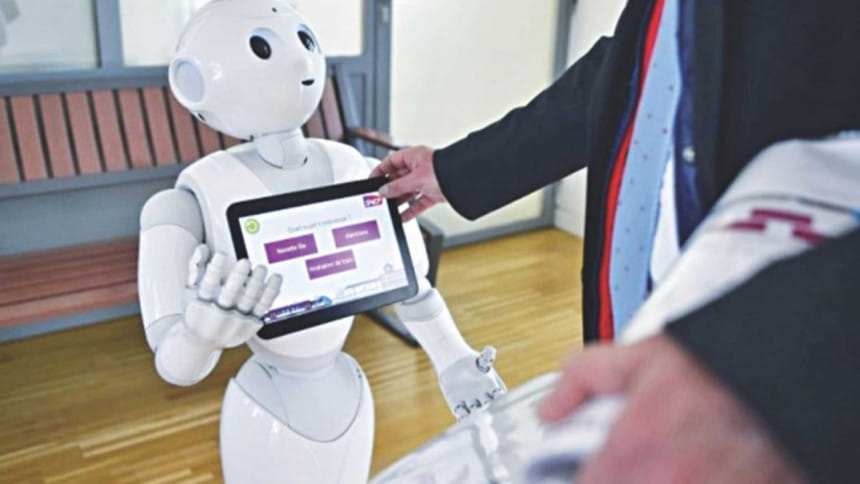Why Bangladesh should invest in artificial intelligence

In the 1970s, American sociologist and economic historian Immanuel Wallerstein (1930-2019) proposed an approach to view the global economic system as an interplay between three groups of countries: core, semi-periphery, and periphery countries. The core countries possess the highest levels of skills and knowledge and the largest amount of capital. The semi-periphery countries serve this group with lower-skill, labour-intensive production and raw materials. The periphery countries, in turn, service both groups with even lower skill levels and more labour-intensive production methods. The approach later came to be known as the World Systems Theory.
The system is dynamic: a country may move up or down the hierarchy depending on its technology, capital, or knowledge. Such movements involve fundamental shifts in a country's social and economic systems—e.g. production, distribution, learning, and skill level. For example, India was once an agriculture-based economic powerhouse, and the European traders clamoured to import its products. But as Europe became industrialised, the importers soon became exporters, and India's agriculture and home-based small industries drastically declined. The money extracted from India fuelled the First Industrial Revolution (late 18th century), funded research and development, and expanded the Western countries' knowledge base. Yale, a highly regarded American university, benefitted from Elihu Yale's (1649-1721) donations, who earned a fortune from the slave trade in India.
The second (late 19th century) and the third (mid-20th century) industrial revolutions soon followed on the back of the first. Both revolutions caused the status of countries to remain generally static; the core countries stayed ahead of the others primarily because of their control on capital, besides knowledge and skill.
The world is now going through the Fourth Industrial Revolution (4IR). According to Klaus Schwab, founder and executive chairman of the World Economic Forum (WEF), the 4IR has transformed the world with an entirely new production, management, and governance system. It can potentially alter Wallerstein's World Systems Theory, because skill and innovation will determine a society's place in the future, reducing dependence on capital. It thus opens new opportunities for the non-core emerging economies to move up Wallerstein's ladder. Schwab added that artificial intelligence (AI) would be a crucial driver of the 4IR. A good thing about AI is that emerging economies can also benefit from this technology without cost-prohibitive investments. The International Finance Corporation (IFC) highlights the same point with ideas and case studies in emerging economies under its thought leadership programme. Below are some of such case studies.
AI for emerging economies
Any effective poverty alleviation initiative needs data to identify vulnerable groups. However, the unavailability of quality data often leads to poorly designed interventions—such as incorrect identification of a vulnerable group—and their eventual failure. AI can analyse satellite images to extract relevant information, such as distance from the nearest water sources or the urban market, crop status, and other relevant variables for detecting vulnerability.
Bengaluru, in Southern India, is experimenting with a system to monitor real-time camera feeds to control traffic lights. In Rwanda, commercial drones are flying medical supplies, such as blood, to remote locations faster than road transport. AI can correlate data from mobile phones with financial affordability, education level, and health status. Such data will allow mobile applications to deliver microlending, tailored education, disease diagnosis, and medication advice. With Natural Language Processing (NLP) tools, AI can cross literacy barriers and communicate directly with an individual in any language.
Options for Bangladesh
MIT professors Erik Brynjolfsson and Andrew McAfee believe that technology will create abundance, but not everyone will benefit equally. Those with talent will be more likely to secure the high-skilled, high-pay jobs, leaving the low-skilled, low-pay ones for the rest. The 4IR's impact on societies will be determined not by technologies, but by the choices one makes. What choice will Bangladesh make?
So far, Bangladesh's economy has been heavily dependent on low-cost products, such as garments—earning more than 80 percent of total annual exports, according to BGMEA—and remittance from low-skilled migrant workers—over USD 24 billion in 2020-21, according to Bangladesh Bank. Should it continue providing low-cost production and labour? Or can it train its abundant young population and make use of the opportunities presented by the 4IR?
How Bangladesh can benefit from 4IR
A Brac study, titled "Youths of Bangladesh: Agents of Change," offers some interesting insights. Bangladeshi youths are not yet prepared to take the opportunities provided by the 21st century (i.e. 4IR), and their potential remains vastly unrealised. It has just about 600,000 tech freelancers, although a whopping one-third of its 163 million (World Bank's 2019 estimate) people are between 15 and 35 years. With the right skills and investment, these youths could become game-changers.
Bangladesh adopted its AI strategy in March 2020, although there is no visible follow-up yet. China adopted its AI development plan in July 2017. Within merely four years, the sheer scale of China's drive towards AI implementation is mind-boggling, as the think tank New America reported in "From Riding a Wave to Full Steam Ahead." China's government entities, universities, research institutes, local bodies, and corporations are spearheading its AI vision of becoming the global leader by 2030. A Forbes article already views China as the world's first AI superpower.
But Bangladesh is not China. The two countries' social, political, and economic systems are vastly different. Bangladesh must find a path to reap the benefits of AI technology. Given its focus on science and technology, Bangladesh can start by setting up a few dedicated AI research institutes and attracting top talents to work for them. It can initiate AI-based research programmes targeting local problems such as Bangla NLP, manufacturing process automation, farming support, tailored education, or healthcare service to remote populations. Low-cost production base and unskilled labour would soon become redundant, just like horses no longer pull carts or carry coal from the mines. The only way to remain relevant is to adopt technology for faster and more equitable growth. Bangladesh cannot afford to miss the opportunity that 4IR offers.
Dr Sayeed Ahmed is a consulting engineer and the CEO of Bayside Analytix, a tech-focused strategy consulting organisation.

 For all latest news, follow The Daily Star's Google News channel.
For all latest news, follow The Daily Star's Google News channel. 



Comments